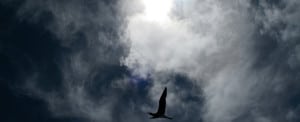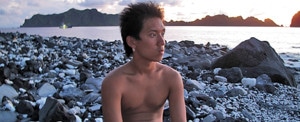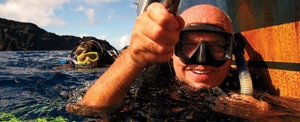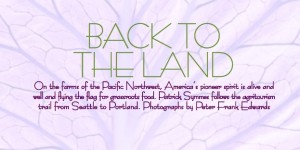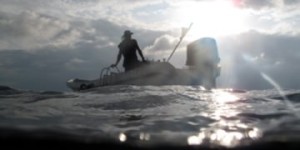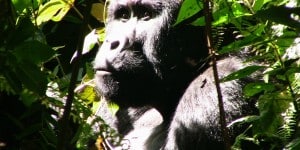By the time George W. Bush created the Marianas Trench Marine National monument, he had shocked his detractors and quadrupled the size of the planet’s fully protected waters. But if a preserve is created in the middle of the ocean and no one is there to see it, can it make an impact?
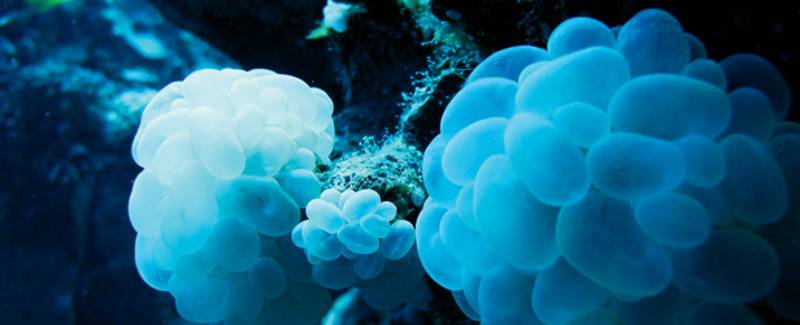
Bubble coral in a crevasse of a submerged volcano, Marianas Trench Marine National Monument
Photograph by Patrick Symmes
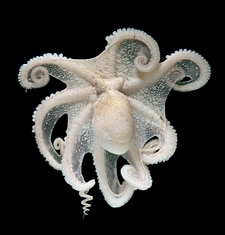
From Archipelago: Portraits of Life in the World’s Most Remote Sanctuary
(Photograph by David Littschwager and Susan Middleton)
The time is April 2006, the movie is Voyage to Kure, and the Cousteau is Jean-Michel, son of Jacques. The you in question is George W. Bush, who became that night a titan of environmental conservation.How did we ever get to a sentence like that? Maybe it started 34 years ago, when the people of the faraway American protectorate of Saipan wrote a constitution that wrapped lonely volcanic islands in legal protection. Maybe it was eight years of pushing by obscure science bureaucrats at the National Oceanic and Atmospheric Administration and the National Park Service. Maybe it was the years of advocacy by Jay Nelson, director of global oceans legacy at the Pew Environmental Group, or Jim Connaughton, head of the White House Council on Environmental Quality under Bush. Maybe it was First Lady Laura Bush, who loved the photo bookArchipelago, showing undersea creatures of the Pacific against solid backdrops. Maybe it was even Bush himself. Known for his love of weed whackers and snowmobiles in parks, the president did love to fish. Maybe he wanted a blue legacy worthy of the oceans. Maybe all these things had to happen together to make the next step possible.
What happened then is that George W. Bush showed up for movie night. It was a documentary on the rarely seen Northwestern Hawaiian Islands, a skein of rocks and shoals tailing 600 miles from the main mass of Hawaii that have long deserved protection from pollution, overfishing, and tourism. Bush watched the entire 120-minute film, and then stayed to eat.
“I was surprised he showed up, and even more surprised he stayed for dinner,” recalls Sylvia Earle, the noted marine biologist and National Geographic explorer in residence. The event’s “open seating” was stage-managed by Connaughton so that the president was impounded faster than a Kennebec lobster. Cousteau sat on one side of the POTUS, and Earle (known as “Her Deepness”) on the other. Key scientists and sanctuary managers were settled into the adjacent chairs.
“I don’t remember what we ate, but it was a very nice meal,” Earle says. “Six of us had an hour and a half of intense conversation.” They talked about marine science, fisheries, conservation—”why the ocean matters, basically,” she said. Bush was surprised to hear that many marine sanctuaries are actually “management areas” where fishing and commercial activities are normal. (“Then why do you call them sanctuaries?” he asked.)
Earle did not miss her chance. Knowing the president’s piscatory predilections, she threw out a line. “I found myself saying to him,” she recalls, “‘If there are to be fishermen, there have to be fish.'”
It’s an obvious point, one she says she repeated twice that night. But the Decider always liked obvious points. The president listened, debated, and then ended his evening by standing up and asking a question.
The exact words vary from witness to witness, but by most accounts, what the President of the United States said that night was this: “Isn’t there something I can do?”
THERE IS, SIR! Ramp up the survey boats, fire all PowerPoints: It’s time to protect a huge expanse of ocean forever with Presidential Proclamation 8031.
Teddy Roosevelt was the first to do this, creating national monuments around natural monuments with an “antiquities” designation that supersedes local interests and bypasses congressional review. After that April 2006 film night, Bush did indeed do something, using the same Antiquities Act of 1906 to create the Northwestern Hawaiian Islands Marine National Monument, which, at 139,793 square miles, was then the largest marine reserve in the world. In January 2009, two weeks before leaving office, Bush struck again, creating two more ginormous marine national monuments, one at the Line Islands, in the mid-Pacific, and the last in the far western Pacific, called the Marianas Trench Marine National Monument. With those two added to Hawaii, the total protected water was 322,000 square miles—bigger than Texas itself. With a few strokes of his pen, Bush had more than quadrupled the area of fully protected marine reserves in the world.
The Marianas sit in the northwest Pacific, in the bowl formed by New Guinea, the Philippines, and Japan. On a map they’re a tiny row of 14 dots, remote even from the rest of the Pacific, but at wave height the islands unfurl in a stately line along the horizon. In three sections covering 95,216 square miles, the monument protects three volcanic islands, 21 underwater volcanoes and thermal vents, and a 1,100-mile stretch of the Mariana Trench—at 36,000 feet, the deepest place on earth. Manganese nodules, scattered at 30,000 feet like so many gold bars, will be safe from robotic mining; the fragile habitat around these volcanoes will be closed to dragnets. Scientists will have free rein to study the area’s bizarre geology—like “champagne vents” that gush carbon dioxide, creating the same effects today that global warming will bring a century from now. Here in the remotest place in American territory, a pristine outpost of the old Pacific with clear seas and smoking volcanoes, a new catalog of life will be read.
The only problem with the new monument was that almost nobody had dipped a toe in it. Earle had never been. Though Jean-Michel Cousteau’s father had filmed off Saipan, the Marianas’ main island, Jean-Michel had made his movie in Hawaii. Jim Connaughton had only flown over the region. Even the monument’s supporters on Saipan were dependent on maps, not visits. The main traffic has been science ships from NOAA, the agency that will administer the monument jointly with the U.S. Fish and Wildlife Service. In the past decade, NOAA has made six trips to the area, to appraise the coral, examine underwater vents, and explore submarine volcanoes. For public purposes, the new monument was lying out there, unseen, untested. There were no dive boats, no tourism, and no ferries anywhere north of Saipan. A local company offered me a helicopter ride to the monument—$14,000 to have lunch on a volcano.
Finally, in the summer of 2009, Friends of the Monument, a group of supporters on Saipan, found a rusting 105-foot long-liner, the Lady Carolina, that could make a ten-day tour of the northern Marianas for $20,000. The Pew Charitable Trusts pitched in $11,000 for fuel and expenses, and Friends of the Monument found ten people, including me, who would pony up $2,000 each for the charter.
The politicians had done their thing and gone home, leaving no programs or infrastructure, and we were inaugurating public access to one of the world’s largest marine reserves with a ramshackle crew of amateurs. We would sail 300 miles due north, beyond range of assistance, past the wreckage of some of the cruelest battles in World War II, dodging a dozen touchy, slightly hot, irritable volcanoes plugged right into the earth’s magma.
Almost nobody had been through since the Marine Corps in 1944. Out here, the world itself fell away.
THE WRITER WILLIAM STYRON, who was deployed to the Pacific at the end of the war, wrote of flame trees, bougainvillea, and hibiscus on Saipan, with snails the size of Ping-Pong balls. The island is still littered with Japanese cannons, and offshore from the McDonald’s is an American tank that’s been sitting there since a wave of 8,000 Marines came ashore on June 15, 1944.
Styron’s “greenish lightning” still flicks over Saipan, but the people are American citizens now, living in the Commonwealth of the Northern Mariana Islands, which looks and feels like a U.S. state but is nominally independent and includes all the Marianas but Guam, to the south. The population of 50,000, almost all of whom live on Saipan, includes indigenous Chamorros and Caro-lineans, both Micronesian peoples; a few thousand U.S. expats looking for a tax-free lifestyle; and tens of thousands of foreign contract workers, mostly Filipino or Chinese, who sewed “Made in America” T-shirts for Asian wages until the garment industry collapsed. The result is a discount American colony with great sunsets and lots of massage parlors and foreclosed shopping malls.
I was picked up at the airport by Angelo O’Connor Villagomez, a 31-year-old Chamorro from a prominent Saipan family and one of the directors of Friends of the Monument. The next night he gathered most of the ten voyagers at Wild Bill’s, a Thai restaurant, to tell us about the outer islands.
“I call it my personal Neverland,” he told his crew. His father had sailed to the northern islands several times, but this would be Angelo’s first visit, as it would be for all of the passengers. “A big part of going is to document what it looks like and bring that information back to Saipan so that people understand what they have,” he said. “There was some controversy when this was created. People didn’t understand why we want to protect it. It is so spectacular, one of a kind, basically untouched. If they know what is there, people will be willing to help us.”
In addition to the boat crew—three Filipino hands and a 61-year-old American first mate named Garry Evilsizer—there would be ten on board. Fresh-faced Angelo was an up-and-comer with a strong marketing instinct—he spoke of “rebranding the Marianas as special and untouched”—and had once run for mayor of Saipan (he lost by 700 votes). The hard-boiled captain, Carl Brachear, was a midwesterner who’d come to Saipan late in life as a merchant mariner. Drafted onto the trip at the last moment, he wanted to make the first civilian circumnavigation of the monument islands. Laurie Peterka was Friends of the Monument’s organizing engine, a Californian who’d come to Saipan in her twenties and was still here 16 years later. Chris Pala, a 58-year-old freelance writer, had come from Washington, D.C., to see the big fish and carbon-dioxide vents; Ken Kramer, 50, and Bryan Jones, 67, were both volunteers in the monument cause, obsessed with (respectively) fishing and diving. During the fight to create the monument, Ken had quit his job at Saipan’s U.S. Department of Agriculture office to stand outside the Costco collecting signatures.
The recreational gene was strong on the boat. Glenn Smith was a 41-year-old teacher who craved spearfishing, and Dr. Jenny Linden, our medical officer, and her husband, Tom, liked the monument—and loved any dive that would get them off Saipan.
Who didn’t want off Saipan? The last spot was awarded to Dennis Chan, a 19-year-old student who’d won an essay contest with a piece arguing that “Saipan sucks,” about his hope that the monument would open new horizons for the islands’ bored, alienated kids, who spent their time on Facebook, watching other people’s lives. Not that we would see poor Dennis often: He couldn’t swim, and spent much of the trip in his bunk, ill.
We’d meet at dawn, ready to sail 300 miles straight to Maug, near the far north of the chain. Maug was said to be the greatest prize in the monument, green and covered with birdlife, its wide lagoon offering a rare sheltered anchorage amid 5,000-mile rollers. There was to be a solar eclipse in two days, which we’d observe from its safe harbor.
After that, we’d check out the other two big islands inside monument waters and return via the seldom-seen islands to the south, getting back to Saipan in ten days.
But the boat went nowhere at dawn, midmorning, or lunch. In the afternoon it was finally loaded with 6,500 gallons of bunker fuel. We had 35 scuba tanks but no dive master; five kayaks and a tiny dinghy with an awful outboard; enough spearguns and fishing rods to make the ocean run red with blood; the usual allotment of spaghetti, granola, and oatmeal; a dozen cans of Spam and two dozen of corned beef; and 20 cases of Bud Light. Lock and load.
During a beautiful pink sunset, we slid out of the harbor, turned north, and for 40 hours raced toward Tokyo, slicing through flat seas. There were a few warning signs already on this cruise, like the first mate, Garry, who repeatedly mistook planets for airplanes and insistently hailed what turned out to be a large rock. (“Come in, naval vessel southeast of Pagan, come in!”) But the weather was good and, late on the second morning, we slid into the embrace of Maug’s lagoon an hour before the eclipse was to begin.
AS THE FIRST person to report live from an aquato-eclipse, I’m here to tell you the shocking news: Absolutely nothing happened. The anemones never blushed. The chubs schooled in common order. No sharks or octopuses panicked. It didn’t even get dark. It was a 93.5 percent eclipse, which in real terms turned out to be almost no eclipse at all. Using a welding mask, we could watch the midday sun gradually reduce to a crescent, and it grew a little gray and cool as we anchored the ship. There was more than an hour of this spooky light, as if the world had put a hat on. But when I leaped over the side of the Lady Carolina with Ken, the volunteer who’d stood outside Costco, for our first swim, we got nothing. We finned over to the westernmost edge of the mile-and-a-half-wide lagoon, and worked our way along the drop-off. Maug was actually three small islands, nearly touching, formed from the remains of a volcano. We were swimming in the caldera, the hole left behind when ancient Mount Maug had blown its top.
According to Pew, the NOAA scientists who’d come this way had rated Maug as one of the world’s great dive sites. But we found no verdant Pacific atoll. Freediving took me onto slopes of barren volcanic gravel. There were bluefin trevally and small gobies but nothing shocking, big, or plentiful. The marginal environment left room for only a few small roundels of whitish acropora coral. With its mixture of great depth and rare habitats, the region is rich in biodiversity, NOAA says. But in three days of long dives, everyone was disappointed. While we eventually found a colorful section of coral, complete with garden eels, barracuda, puffers, triggerfish, and even a blacktip reef shark, there was better diving back on Saipan.
Sylvia Earle later scolded me for calling the monument barren. I had been focused on big critters, she pointed out, but the Marianas wells up with biological oddities. “You have to know what to look for,” she said. “It’s not about just the big, showy things. The diversity in a bucket of water can be more diverse than the genetics of a rainforest. It’s about getting people to look with new eyes at what’s in front of them.”
I don’t have the gift of new eyes, but it’s still sweet to be sun-warmed and then dipped in cool water every day. In the evening we’d crowd into the galley, cooking huge, messy meals and arguing over the day’s photography: Were those highfin rudderfish, or merely chub? Late at night, we’d sprawl on the foredeck, gossiping and eating snack mix. The stars emerged, pinpricks on velvet, the planets so bright they held their own halos in the moist air. We were close to the equator here, the days about the same all year, the shifting cloud fields and occasional brushes of rain the only evidence that weather exists. The forecast in Saipan is pretty much always like this: high of 88 degrees, humidity 59 percent. Some outsiders, especially Canadians, take to it instantly.
There were a lot of no’s up here: no tourism, no facilities, no villages, no ports, no dive boats, no coast guard. We were alone. We didn’t see a boat for ten days (not counting the “Pagan Navy,” as we labeled the rock that Garry had hailed). Our mere presence was enough to attract a U.S. Air Force C-130, which appeared overhead one morning and circled us repeatedly.
On the second day at Maug, Chris Pala, the writer, fired up our dinghy’s tiny outboard motor, and Bryan and I helped him scout for those carbon-dioxide champagne vents. Deeper vents in the region oozed liquid sulfur—we were floating over an access point to the earth’s core. Maug’s volcanic slopes dropped almost immediately to the bottom of the Mariana Trench. Chris led us east, west, and finally south in the lagoon, chasing any line of bubbles, diving in promiscuously, and eventually dragging Bryan behind the boat on a rope—a standard survey technique that left the game 67-year-old choking on seawater and exhaust.
When we looked up, we were outside. Chris had trolled us out of the lagoon and around the southern tip of the east island, into the Pacific. With no line of sight to the mother ship, our little radio was useless, and this was of course when the outboard failed. For a moment we sat there, riding up and down on the rollers, silent, listening to the surf crash on boulders 200 yards away.
Then the motor started, and we went back to the boat. The big rollers haunted me that night, though, a reminder of just who is in charge out here.
A BRIEF INTERRUPTION from our sponsor, if you don’t mind. That would be the sea, and everything in it. This planet is blue, after all. We ourselves are mostly water.
The Mariana Trench is a narrow crevasse, like a reverse mountain range, about a mile deeper than Mount Everest is high. (“If it was on land, it would have been a national park a hundred years ago,” Jay Nelson said.) Down at the bottom, even 16,000 feet of pressure per square inch does not deter life. Vents of mineral-rich brews feed chemosynthetic forms of life that have never known sunlight. Only two people have ever been to the bottom—U.S. Navy lieutenant Don Walsh and Swiss oceanographer Jacques Piccard—and that was in 1960. We know more about the surface of the moon than the floor of the Pacific—even its true depth, which gets adjusted downward from time to time. Current estimate: 36,201 feet.
“Almost certainly, new forms of life will be found,” Sylvia Earle said. Yet the specific opportunities in the Marianas Trench Marine National Monument missed the point, she insisted. “Many people still look at protected areas as a luxury, as if we could take it or leave it,” she said. “They don’t get it.” With perhaps 90 percent of large commercial fish extracted from the seas already and pollutants entering at an astonishing rate, “the basic processes that keep us alive” are being disrupted, Earle warned. Before Bush made his three monuments, the global total for ocean sanctuaries was only 1.1 million square miles, with just 12 percent of that under full, “no-take” protection. (Some of the biggest “protected zones,” like the Great Barrier Reef, have only limited restrictions.)
Yet Bush’s big reserves are still just a fraction of 1 percent of the total ocean. Hawaii was a starting point, the Marianas a way to build momentum. Now a much larger global network of marine sanctuaries is needed to let the ocean recuperate from our massive extraction of resources and input of pollutants. In April, after three years of meetings with Pew, the British government created a 210,000-square-mile reserve in the Indian Ocean, the new world record. Still, Earle suggested that up to half of the total ocean should be in sanctuaries. “When people say, ‘How much ocean should we protect?'” Earle noted, “I say, ‘How much of your heart should you protect?'”
But you don’t have major interest groups claiming bits of your heart. The creation of Hawaii’s monument, which runs 600 miles out to Midway Island, was hotly contested. Those northwestern islets were a sacred zone in traditional culture, actively claimed by Hawaiian monarchs. (To reflect this, the name was changed to Papahanaumokuakea Marine National Monument.) These taboos meant accommodating a handful of longtime fishermen while excluding virtually all other uses.
“Thank God we didn’t have Hawaii’s politics,” Angelo told me. That’s not to say there wasn’t resistance. Calling the plan a federal power grab, the House of Representatives in Saipan denounced it, twice, and the governor, Benigno Fitial, worked to block the proposal. Although there was no fishing industry in the monument area, WesPac, the federally funded authority for regulating western Pacific fishing, supported local opponents, feeding a campaign of fearmongering, anti-federal posturing, and bizarre claims that the monument—340 miles to the north—would shut down popular fishing spots on Saipan.
Connaughton, the White House adviser, once found more than 100 opponents waiting for him at the airport, and then, at his hotel, almost as many supporters. Three hundred crowded into one meeting, with supporters in orange shirts arguing that a monument would expand scientific research, create a nursery effect for fish, and bring jobs for a museum-like visitor center and growth in dive tourism. Opponents, including some in Micronesian shell necklaces, complained that federal rules would displace local rights. I tracked down an eloquent spokesman, Hernan Tudela, a Chamorro traditionalist, as he threw a casting net at Lau Lau Beach, on Saipan. “We have 2,000 years of fishing culture,” Tudela told me. “We got two minutes to explain that.”
Tudela’s skill with a net left me humbled. But we were talking on Saipan.There is no traditional fishing up in the monument area, no archaeological sites, no ancient canoes. Not one person lives on the three islands inside the designated zone. There is also no oil, one factor that stopped a monument proposed for the Gulf of Mexico.
Yet the sanctuary that finally emerged was not what its supporters had expected. Only 12,388 of those 95,000 square miles received an absolute ban on fishing; a much larger area was what Angelo called a “paper park,” protected only at depth against commercial uses like mining and drilling. One supporter compared the result to an elephant straining for years to produce a mouse-size turd.
On the Lady Carolina, Angelo tried to keep it all in perspective. He reminded us of Grand Canyon National Park, which has grown by half since Roosevelt named it a national monument in 1908. “We’re just starting a hundred-year process,” Angelo said.
BUT NOT A MINUTE to waste. At six o’clock the third morning, Angelo turned me out of my hammock on the foredeck. “Big school of tuna,” he said. “Can you handle an outboard?”
Five minutes later, the two of us were chasing splashes around the lagoon, trying to get over the fast-moving skipjack and under the brown noddies who were diving on them. We jumped into the water with masks and fins, spreading out in an attempt to herd minnows into a bait ball. Eventually the fish did come past, in a blazing school, rocketing upward to touch the surface and snag minnows, then bouncing down again as the noddies attacked with a mirror gesture from above, breaking the surface plane and then scrambling back into the invisible air.
By 7:45 we were back on the Lady Carolina, rousing the sleepers for breakfast. This was no dive boat, and the lousy cabins, messy kitchen, and self-catering produced a sense of unsettled grudges. At a breakfast meeting, we tried to plan the second half of our trip. We were 300 miles from Saipan, with six days left.
With no real leader, we tried democracy. The recreators, like the Lindens and Glenn, wanted to head south, to flatter islands outside the monument, where we could build campfires, spearfish, and dive. Angelo, Laurie, Carl, and I argued for going north to make a full survey of the monument—wasn’t that why we were here? A confused vote produced a confused plan: The next day we’d make a fast run north to the last island, Farallon de Pajaros, the remains of the Uracas volcano. Then we’d turn south, down the archipelago, pausing for rapid bursts of recreation. Two people slept through the meeting, and Chris wanted a re-vote. We were in factions now, people whispering behind the smokestack about small resentments: food, money, alcohol, bedding. So it goes on boats.
Yet our final dive at Maug was an everybody-over-the-side success. The lagoon is 800 feet deep in places, but the old volcanic tip had rebuilt itself to 65 feet at one small spot. Nine divers clung like grapes to a rope as Garry towed us around with the Lady Carolina, looking for that bull’s-eye. Eventually we dropped down a water column as clear as glass, my shadow playing below me on the thermocline, an underwater specter. The volcano’s tip was busy with juvenile fish and a whitetip reef shark, and littered with giant clams, mushroom and acropora staghorn coral, and white bubble coral, poisonous by night. It was a spot of verdant life in this tough place. Too soon we were struggling back up the Lady Carolina’s broken ladder and hauling anchor to speed north.
Within an hour we were passing Asuncion, a volcano green with grass, and then came the Farallon de Pajaros, a steaming brown cone of active trouble, stained with yellow sulfur, the reds of mysterious deep-earth elements, and black gravel ejecta. We circled the peak just once, a pair of large dolphins on the bow wave the only sign of life. With this farthest turn, Captain Carl had ensured his circumnavigation.
When we came around the eastern side of the peak, we were edging the Trench itself. I tossed a quarter overboard. When it reached the bottom, several hours later, what unknown creatures would be waiting?
We steamed south all day, nothing but fun ahead of us. But at 11 P.M., as we sat chatting on the foredeck, Laurie stared at the darkness and said, “That’s not an island, is it?”
Hmmm, let’s see: big, volcano-shaped, and dead ahead.
I ran back to the bridge. Garry was asleep at the wheel, a romantic comedy playing over the navigation map. We were moving at eight knots back toward Asuncion. It wasn’t exactly a Titanic moment—”We’re miles away,” he said defensively when I woke him up—and a flick of the wheel steered us toward safety.
But he wasn’t much of a sailor. When he wasn’t radioing rocks or steering for islands, Garry was fixing the dinghy motor—which then stranded us again. He was the only person on the boat who’d been up north, but he told me he hadn’t done any fishing—and later said how good the fishing had been. He had several big scars and explained, with remarkable candor, that the big one across his head had come from a pipe. In his previous life on the mainland, he’d been in jail for 27 years, had killed a man with a shiv, and had himself been stabbed eight times. After prison, he’d married his lawyer, come out to Saipan, and joined a church. Whatever his past, Garry deserved a place to go. Saipan was that corner of America, where misfits feel right at home.
WE EXITED THE monument itself and landed on Agrihan, a big, rolling island covered with palm trees and bathed in low clouds, where heavy surf tossed the dinghy vertical and dumped gear everywhere. (“Typical North Marianas landing!” Angelo exulted.) We were surprised to find four men on the island. They were a family of Carolineans, dressed in heavy-metal T-shirts. The patriarch, 35-year-old Eddie Suares, showed us their cinderblock house in the palm forest. They’d come out a year ago, abandoning Saipan’s diet of Bud, Spam, and television to survive as their ancestors had. “We are healthy here,” Eddie said. “We have a good life.”
“Do you need any supplies?” Angelo asked.
“Nothing,” Eddie replied. They had a radio and with a few weeks’ notice could arrange for a boat. They harvested plentiful coconuts, caught fish with spearguns, ate bananas, made palm wine, cooked huge coconut crabs, and cultivated a marijuana patch, which was fenced against their goat. The USDA had also given them a clever plastic evaporator that, when exposed to sunlight, turned salt water into fresh.
Chris Pala asked about women. “Everyone ask that!” Eddie retorted. By “everyone” he meant a couple of New Zealanders who’d passed by in a yacht months ago. (“We just get them come for massage-y,” he explained of women, “then send them back.”)
This being the Pacific, we exchanged gifts. They accepted rice, some cans of beer and corned beef, and a few minutes on the satellite phone. Eddie was eyeing a roll of duct tape, so I handed it to him. I hoped it would fix an engine in a storm or seal a hemorrhage, but no. “It’s good for packages,” he explained.
What they gave us was a rescue. Chris and I were 50 feet out in the dinghy when our motor failed, again. The Carolineans leaped into their boat and towed us out to the Lady Carolina.
We spent the next days island-hopping. Pagan was the Marianas’ main candidate for ecotourism, with a landing strip, some good beaches, and forests of ironwood, an invasive Australian pine that threw a lot of shade. I found a Zero full of bullet holes in the weeds, and a Betty bomber that had crash-landed, two of more than 400 Japanese planes destroyed during the Marianas Turkey Shoot. More than 1,300 U.S. servicemen had gone missing in action in the northern Marianas and Guam, ample justification for using the Antiquities Act to create a monument.
Saipan, which welcomes misfits, deserves its own new beginning. The monument is remote, still an abstraction, but Saipan’s current malaise—its vanished garment industry, the drop in Japanese tourists—could be arrested by a new sense of the possible. Dennis Chan, the student on board, thought opening up the monument would give lost young people a hint of a future.
It’s nice to fantasize about dive trips to Maug a decade from now, or tourists swinging through a visitor center on Saipan. The unusual ocean chemistry here could draw scientists looking for a “predictor of climate change and changing ecosystems,” says Susan White, Fish and Wildlife’s new project leader for the Pacific monuments. But White warned me, twice, that funding for a visitor center is scarce in these tough times, especially given the dozens of similar proposals for less remote places. In the meantime, Angelo Villagomez wrote me recently, the monument’s status was this: “No advisory council, no draft management plan, no scoping meetings, no visitor center, no jobs, nothing.”
At our last stop, Sarigan, we ran into our own limits. Sarigan finally offered the superb diving we had been looking for: a cavalcade of beehive corals, teeming reefs, and a Tahitian wrasse the size of a surfboard. But heavy seas canceled a second dive. Equipment started blowing off the boat. We lost our anchor. Strong currents carried off two spearfishermen and then the dinghy that went to fetch them. The motor failed again.
Then we lost the spare anchor, too. That was the end: We couldn’t hold position on a wave-lashed shore, and Carl turned us south for the 100-mile run to Saipan. At midnight we saw Garapan, the commercial downtown, glowing from ten miles out.
As we slid into the harbor, Dennis emerged from his bunk for the first time in days. He threw his fists in the air and screamed, “Saipan doesn’t suck!”
